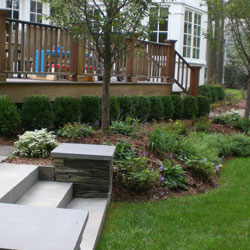 Redoing your landscape, whether you are starting from scratch, updating parts of an existing design or completely renovating your yard, can be a lengthy and expensive process. Phased landscape installation can help you adjust your time, labor and budget to create your dream landscape in easy-to-manage steps.
Redoing your landscape, whether you are starting from scratch, updating parts of an existing design or completely renovating your yard, can be a lengthy and expensive process. Phased landscape installation can help you adjust your time, labor and budget to create your dream landscape in easy-to-manage steps.
How Phased Landscape Installation Works
Instead of doing an entire large landscape at one time from start to finish, phased landscape installation breaks the project into more manageable pieces. It may take several weeks, months or years to complete the landscape installation in phases, depending on the size of the project and what resources are available to complete it.
Phased landscape installation can be beneficial in several ways. Not only does it make a large project more manageable, but it also allows for tweaks and refinements throughout the process as needs, preferences and living styles may change over time. Installing a landscape in phases can also better accommodate a limited budget or limited time with shorter seasons, while still allowing for the yard, garden and landscape to be used and enjoyed before the full project is complete.
Designing a Master Landscaping Plan
Creating a master landscaping plan is a critical first step in phased landscape installation. A master plan is necessary to keep the landscape’s end result in mind, and that plan can be adjusted as needed throughout the different phases. When the full project can be envisioned, it is also easier to plan the order of phases to be installed with the greatest efficiency so there is less disruption to established parts of the landscape when a new phase is begun.
The first part of a master plan should involve a comprehensive evaluation of the site and its landscaping needs. This should include soil condition and quality, drainage concerns, sunlight levels, potential erosion problems and more. This evaluation can help direct the landscape installation to correct difficulties with each step. After the overall evaluation, the first phases of landscape installation need to be sufficiently detailed for the project to get underway. Later phases and finishing touches may change by the time the final phase of installation is ready to begin, and so those phases may not necessarily be as firm when the landscaping plan is first developed.
It is important to keep the master plan accessible, especially when it may take several years to fully install a larger, more elaborate landscape. Notes, changes, suggestions and updates should all be documented. This will ensure that all contractors and experts – who may change over the years – are aware of the overall landscape vision.
Landscape Phases to Plan
The order of projects in phased installation will vary depending on the overall master plan for the landscape, as well as how each phase is integrated into the overall process. Needs and preferences can also influence which phases are implemented first to ensure the landscape is usable and enjoyable from the very first phase. Typical phases in a landscape plan may include…
- Surfaces – Sod, seeding, groundcovers, or mulching for erosion control and visual appeal.
- Hardscapes – Borders and edging, terraces, retaining walls, etc.
- Gas and Electrical Lines – Support for water feature pumps, lighting, outdoor kitchens, etc.
- Irrigation – Sprinkler systems and drip plans as well as drainage adjustments.
- Shade – Large trees and plants to provide shade for outdoor living spaces as well as structures.
- Entertaining Space – Patios, decks, pool surrounds and similar high use spaces.
- Structures – Pergolas, trellises, arbors, sheds, play structures, etc.
- Waterscapes – Ponds or pondless waterfalls, creeks and streams, or fountains.
- Garden Space – Raised beds or dedicated growing areas for practical harvests, fruit trees, etc.
- Pathways – Connections between parts of the landscape or around the entire home.
- Plantings – Shrubbery and flowerbeds, specimen plants, etc.
While the order of phase installation can vary greatly, many plans opt to put surfaces, hardscapes and shade early in the master plan. Surfaces are often used right away and help a landscape look attractive even as the plan is being implemented, while hardscapes establish the borders that will gradually frame the entire landscape. Shade is also important to implement early, as larger trees have slower growth cycles and will take longer to mature and provide their full benefits, so the sooner they are planted the sooner they will be providing that shade. Of course, depending on the exact budget and master landscaping plan, several phases may be implemented at once, or smaller phases may be spread out over a greater period.
In addition to these potential phases, it is important to consider the final phase of landscape installation – care and maintenance. Particularly when plants are young and the ground may still be settling, extra care may be needed to nurture plants and ensure they adjust to their new environment. Proper care, including pruning, fertilization and pest control, will help keep the landscape looking just as attractive and inviting as it is from the first moment of installation.
Are you considering phased landscape installation? Our experts can help develop your master landscaping plan and recommend the best phases to create your dream landscape!


